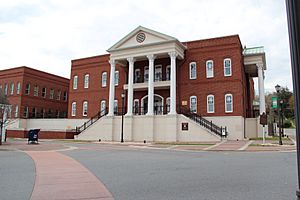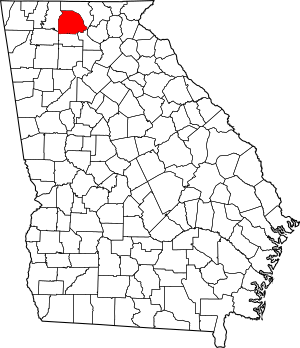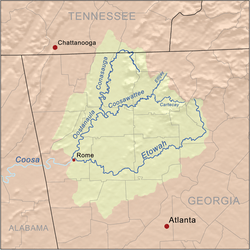Gilmer County, Georgia facts for kids
Quick facts for kids
Gilmer County
|
||
|---|---|---|

Gilmer County courthouse in Ellijay
|
||
|
||

Location within the U.S. state of Georgia
|
||
 Georgia's location within the U.S. |
||
| Country | ||
| State | ||
| Founded | 1832 | |
| Named for | George Rockingham Gilmer | |
| Seat | Ellijay | |
| Largest city | Ellijay | |
| Area | ||
| • Total | 431 sq mi (1,120 km2) | |
| • Land | 427 sq mi (1,110 km2) | |
| • Water | 4.7 sq mi (12 km2) 1.1%% | |
| Population
(2020)
|
||
| • Total | 31,353 | |
| • Density | 73/sq mi (28/km2) | |
| Time zone | UTC−5 (Eastern) | |
| • Summer (DST) | UTC−4 (EDT) | |
| Congressional district | 9th | |
Gilmer County is a county in the Northwest region of the U.S. state of Georgia. As of the 2020 census, its population was 31,353. The county seat is Ellijay. named for a historic Cherokee town also spelled as Elejoy in the 18th century. The county was created on December 3, 1832, and was named for George Rockingham Gilmer, a politician who served two nonconsecutive terms as governor of the state. Gilmer County is home of the annual Apple Festival, which is held in mid-October. About 90% of the land area is in cropland and forest. Poultry raising and processing make up the largest portion of the agricultural economy, which generates 33.2% of the total revenues. Manufacturing is about 20%.
Contents
History
This was long inhabited by cultures of indigenous peoples. It was part of the homeland of the Cherokee. They had a village, Elatseyi, meaning "new ground". Other sources say it means "green place". It was sometimes spelled "Elejoy" on 18th-century colonial maps. It was located at the confluence of the Ellijay and Cartecay Rivers, which create the Coosawattee River. The later European-American town of Ellijay developed at this site.
In 1832, Gilmer County was organized as Georgia started to encroach on Cherokee territory. Ellijay was designated as the county seat in 1834.
On January 12, 1854, parts of Gilmer County, as well as parts of neighboring Union County, were taken to form the newly created Fannin County, Georgia.
This is still a primarily rural county, with agriculture and forests supporting the economy. It also has a growing tourist sector, some based on whitewater kayaking and canoeing on the rivers in the area.
Economy
Farming is still important, although, by 2002, the area of land in the county devoted to agriculture had declined to 24,700 acres. Most farms are sized at 10-49 acres, or 50-179 acres. Poultry raising and processing make up the largest portion of the agricultural economy. Agriculture and directly related businesses, such as landscape services, generate $565.1 million, or 33.2% of the county's economic output. Manufacturing generates $351.4 million, or 20.6%.
Geography
According to the U.S. Census Bureau, the county has a total area of 431 square miles (1,120 km2), of which 4.7 square miles (12 km2) (1.1%) are covered by water. The county is located in the Blue Ridge Mountains.
The vast majority of Gilmer County is located in the Coosawattee River sub-basin in the ACT River Basin (Coosa-Tallapoosa River Basin). Three very small parts of the eastern and northern edges of the county are located in the Conasauga River sub-basin of the ACT River Basin, while slightly larger portions of the northern and eastern border areas of Gilmer County are located in the Ocoee River sub-basin of the Middle Tennessee-Hiwassee basin.
Adjacent counties
- Fannin County (north)
- Dawson County (southeast)
- Pickens County (south)
- Gordon County (southwest)
- Murray County (west)
National protected area
- Chattahoochee National Forest (part)
Transportation
Major highways
Secondary highways
- Old S.R. 5
- Yukon Road
- Burnt Mountain Road (Old S.R. 108)
- Boardtown Road
- Big Creek Road
- Doublehead Gap Road
- Whitestone Road
- Conasauga Road
Demographics
| Historical population | |||
|---|---|---|---|
| Census | Pop. | %± | |
| 1840 | 2,536 | — | |
| 1850 | 8,440 | 232.8% | |
| 1860 | 6,724 | −20.3% | |
| 1870 | 6,644 | −1.2% | |
| 1880 | 8,386 | 26.2% | |
| 1890 | 9,074 | 8.2% | |
| 1900 | 10,198 | 12.4% | |
| 1910 | 9,237 | −9.4% | |
| 1920 | 8,406 | −9.0% | |
| 1930 | 7,344 | −12.6% | |
| 1940 | 9,001 | 22.6% | |
| 1950 | 9,963 | 10.7% | |
| 1960 | 8,922 | −10.4% | |
| 1970 | 8,956 | 0.4% | |
| 1980 | 11,110 | 24.1% | |
| 1990 | 13,368 | 20.3% | |
| 2000 | 23,456 | 75.5% | |
| 2010 | 28,292 | 20.6% | |
| 2020 | 31,353 | 10.8% | |
| 2023 (est.) | 32,860 | 16.1% | |
| U.S. Decennial Census 1790-1880 1890-1910 1920-1930 1930-1940 1940-1950 1960-1980 1980-2000 2010 |
|||
2020 census
| Race | Num. | Perc. |
|---|---|---|
| White | 26,365 | 84.09% |
| Black or African American | 127 | 0.41% |
| Native American | 62 | 0.2% |
| Asian | 131 | 0.42% |
| Other/mixed | 1,069 | 3.41% |
| Hispanic or Latino | 3,599 | 11.48% |
As of the 2020 United States Census, 31,353 people, 12,021 households, and 8,028 families were residing in the county.
2010 census
As of the 2010 United States census, 28,292 people, 11,314 households, and 8,000 families lived in the county. The population density was 66.3 inhabitants per square mile (25.6/km2). There were 16,564 housing units at an average density of 38.8 units per square mile (15.0 units/km2). The racial makeup of the county was 92.3% White, 0.5% Black or African American, 0.3% Asian, 0.3% American Indian, 0.1% Pacific islander, 5.2% from other races, and 1.3% from two or more races. Those of Hispanic or Latino origin, of any race, made up 9.5% of the population. In terms of ancestry, non-Hispanic people identified as 18.7% being Irish, 17.3% American, 16.3% English ancestry, and 13.4% German.
Of the 11,314 households, 29.2% had children under 18 living with them, 57.2% were married couples living together, 8.9% had a female householder with no husband present, 29.3% were not families, and 24.5% of all households were made up of individuals. The average household size was 2.48 and the average family size was 2.92. The median age was 43.4 years.
The median income for a household in the county was $36,741 and for a family was $45,317. Males had a median income of $32,177 versus $27,288 for females. The per capita income for the county was $20,439. About 12.4% of families and 18.1% of the population were below the poverty line, including 24.1% of those under 18 and 8.0% of those 65 or over.
Attractions
Gilmer County is home to an impressive specimen of yellow poplar known colloquially as "the big poplar". This particular specimen is 100 feet tall and about 20 feet in circumference at its base. The tree can be accessed via Bear Creek Trail in the Chattahoochee National Forest.
Communities
Cities
Census-designated place
Unincorporated communities
- Ai
- Tails Creek
- Whitepath
- Yukon
See also
 In Spanish: Condado de Gilmer (Georgia) para niños
In Spanish: Condado de Gilmer (Georgia) para niños




